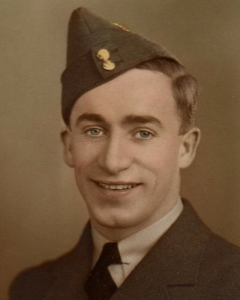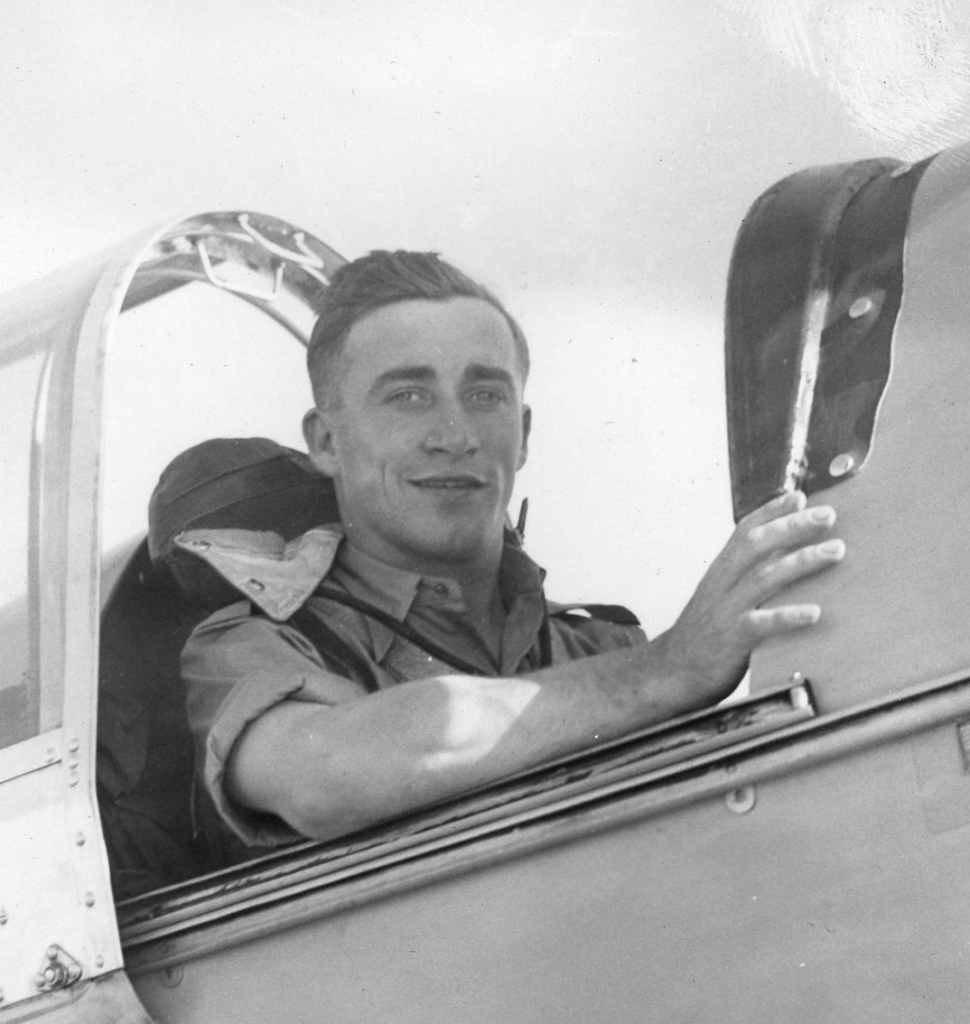James Wright, who always referred to himself as Jim, was born on August 19, 1916 in Sarnia. Jim’s father, Thomas William Wright was born in Isle of Guersney, England and his mother was Margaret (nee Wisby) Wright, was born in Harston, Cambridgeshire, England. Jims’s father, Thomas, had a previous marriage to Harriet Wisby (Margaret’s younger sister) in February 1905, and they would have three children together: Herbert Wisby Wright (born 1906); Ellis John Wright (born 1910); and Florence Wright (born 1912). Thomas would lose his wife Harriet, who died in February 1912 of tuberculosis, and a few days later, their infant daughter Florence would die of meningitis. Two years later in March 1914, the widower Thomas Wright married Margaret Wisby, his sister-in-law who had immigrated to Forest, Ontario from Harston, Cambridgeshire, England around 1905. Margaret Wisby also had a previous marriage, to Charles Kershaw in June 1910, and they would have one child together, Mary Kershaw. Charles Kershaw died in August 1911, about the time that their child Mary was born.
Thomas Wright married Margaret (nee Wisby) Wright on March 5, 1914 in Forest but they lived at 240 Bright Street, Sarnia. Thomas and Margaret Wright would have three children together: Clifford Wright (born 1914), and twins Edith Selena and James (Jim) Wright, born on August 19, 1916, in Sarnia. James (Jim) was given the middle name Le Noury, which was his grandmother’s maiden name (Julia Le Noury of Mount Durand, Guernsey).
Jims’s father, Thomas Wright, living at 128 Penrose Street, Sarnia in February of 1916, and recording his occupation as a grocer, enlisted to fight in World War I. He was to serve with the Canadian Railway Troops, 11th Battalion, attaining the rank of Acting Lance Corporal. A little over two years later, Thomas Wright would lose his life while serving in World War I. Thomas Wright died on November 9, 1918 at No. 56 Casualty Clearing Station. The cause of death was the result of the Spanish flu (influenza and broncho-pneumonia). Many years later, his former wives Harriet Wisby (died in Forest 1912) and Margaret Wisby (died in Sarnia 1964) were both buried in Beechwood Cemetery in Forest. An empty spot lies between them, for their husband Thomas Wright. The space will always be there, as Thomas was buried in France with his fallen brothers in arms. Thirty-seven year old Thomas Wright is buried in Grevillers British Cemetery, Pas de Calais, France, Grave XVII.E.8. Thomas William Wright’s name is also inscribed on the Sarnia cenotaph in the World War I section. Thomas and James Wright were the only father and son combination from Sarnia to both lose their lives while serving Canada in two different World Wars.
So Margaret Wright raised Jim all on her own, along with his other five siblings: Herbert, Ellis, Mary Kershaw, Clifford and Jims’s twin Edith, all at 240 Bright Street, Sarnia. Jim was educated at Russell Street, George Street, and Lochiel Street Schools and then at Sarnia Collegiate, where he specialized in drafting and two years commercial. Jim loved sports, participating in swimming, hockey, football, softball and tennis, and he had a keen interest in photography. After high school, Jim worked as a bookkeeper at Head Laundry Limited for one year, and then as an inspector, and finally as an office clerk at Electric Auto-Lite Limited for 3 years until 1940.
Single at the time, Jim Wright enlisted in the Royal Canadian Air Force in London, Ontario on July 20, 1940. He became a member of the RCAF #41 Operational Training Unit. His training sites included Picton, Dunnville, Toronto and Dauphin. He would receive his wings in October of 1941 at No. 10 S.F.T.S., Dauphin, Manitoba. During his training, Jim flew in a variety of planes, mostly Hurricanes, but also Spitfires, Hudsons, Dakotas, and Marauders. A little more than a year after enlisting, in November of 1941, John Wright would arrive overseas in England. James Wright would arrive overseas along with fellow Sarnian Fred E. Wise (see above), who he had also attended the same training centres with. Both James Wright and Fred Wise would be reunited again with the R.C.A.F. in the Middle East.
In April of 1944, the Sarnia Observer featured a story on Mrs. Margaret Wright’s three children who were serving at the time. Her daughter, Flying Officer Mary Kershaw of the R.C.A.F. (W.D.), attended public school and Sarnia Collegiate Institute. She trained at Strathroy General Hospital and was four years at the Charlotte Eleanor Englehart Hospital in Petrolia. Prior to enlisting, she nursed for 1 ½ years at the Sanitorium in Weston. She enlisted in the R.C.A.F. 16 months prior to the newspaper story. Stationed at Trenton during that time, Mary had recently been appointed to the Radio Station Hospital in Clinton where she was in charge of the 25-bed hospital. Margaret’s son, Clifford W. Wright, had enlisted in January of 1944 in the United States Navy. He had been employed with Mueller Brass Company of Port Huron. Clifford was stationed at Scott Field, Farragut, Idaho, from where he graduated in February of 1944. Following a 21-day leave in Sarnia, Petty Officer Clifford Wright of the United States Navy was transferred to Santiago, California. Her son James L. Wright was also featured in the story. At the time, Pilot Officer James Wright of the R.C.A.F. had been overseas for two years and had been stationed for some time in the Middle East where he received his commission.
Overseas for three years, Jim was on aircraft delivery, flying planes to North Africa, Egypt, the Middle East and to India. This included flying aircraft from the West African coast to the Middle East during the Tunisian campaign, as well as piloting planes to Iran and transports and fighters to India. In August of 1942, James would celebrate his 26th birthday somewhere in the Middle East. In November of 1942, while stationed in Africa, he was hospitalized for close to two weeks, after contracting malaria. One year later, in November of 1943, he received his commission and was promoted to Flight Officer. In late August of 1944, Jim made what was to be his last trip to Sarnia, a 30-day leave to visit his mother Margaret, twin sister Edith and the rest of his family. Jim had completed his duties in Africa, the Middle East and other areas and had been sent back to Canada with the privilege of taking his discharge if he so elected. He had more than 800 flying hours to his credit; however, he chose to continue in the service.
While in Sarnia, when asked what things had impressed him on his return to Canada, Jim stated, “There certainly is no serious shortage of food in Canada. It is wonderful to be able to go into a restaurant and order a steak, and to see a menu with so many choices on it. In England there are no menus now such as there are here, while in Africa, on the ferry command, food was often pretty grim.” On choosing not to take his discharge, he expressed his eagerness to return to the battlefront. “The leave is fine, but I’m not used to having nothing to do, and hope to be sent back overseas again.” He expressed that this time, he wanted to use his training as a fighter pilot to get into the thick of things.
In describing the “grim” accomodations and food to which he became accustomed, he stated that in some of the R.A.F. stations along the ferry routes, native cooks were used with R.A.F. personnel supervising. “We frequently used a native set-up with mud and straw huts, and wooden frames with ropes for mattresses…. The R.A.F. considered it more important to bring in war material first and accommodations later if there was time. The Americans, on the other hand, brought in their equipment first, including prefabricated huts, real beds, complete refrigeration, and so on.” He was unimpressed with Cairo and Alexandria; in fact, Jim was quite disgusted with the lack of proper sanitation he found, even in new Cairo. He said that the old city was dirty and full of disease spread by flies. Nor was he impressed with the Egyptians he found in his travels there, claiming to have lost many articles through pickpocket activities. He described Alexandria as cooler than Cairo in the summer, with a breeze from the Mediterranean Sea. The heat on the West African coast was oppressive with a high humidity, while it was 125 degrees in Iran falling to 100 degrees at night.”
After his leave in Sarnia he reported to Ottawa for posting, he started taking a course on Spitfires equipped both as fighters and for photographic work. In September of 1944, shortly after his leave in Sarnia, the mother of another Sarnia R.C.A.F. officer would show Jim’s mother Margaret a letter that her son had written to her. The officer praised Jim Wright’s splendid record. The letter said that FO. Jim Wright had earned his month’s leave at home by taking part in a particularly hazardous undertaking with two colleagues. It also revealed that Jim, despite three attackes of malaria, had made 46 flights in single-engined fighter planes from the west coast of Africa to Burma and Russia and had spent 10 days in the desert after being forced down by engine trouble.
On March 15, 1945, while flying low in his Spitfire BM636, his plane went out of control, crashing into a field at Paper Mill Lane, Oakenholt, Flintshire, Wales. A local farmer who witnessed the crash, rushed over and pulled Jim Wright out of the plane, but Jim was already dead. Approximately one week later, mother Margaret Wright in Sarnia would receive a telegram from Ottawa informing her that her son, Pilot Officer James Wright was killed recently on active service with the R.C.A.F. overseas. No further particulars were given in the official message. James Lenoury Wright would later be officially listed as, Killed in flying accident, overseas (Wales).
Shortly after news of James Wright’s death, Rev. F.G. Hardy of St. George’s Church, Sarnia, spoke in sympathetic terms at a morning service at the church. The rector said that in peace times, before his enlistment, James had taken an active part in the young people’s work and older members of the Boy Scouts would remember his activities and his talent for leadership. Rev. Hardy added that it was a sad duty to make the announcement of the supreme sacrifice of this young boy. The chaplain in England that presided over James Wrights’ funeral would write to his family:
Blacon Cemetery, just outside the ancient walled city of Chester, is a beautiful spot. The heavy mist that has hung over the countryside has lifted, but the sky was clouded over during the funeral; overhead, two aircraft hovered around as though in tribute to your son.
Twenty-eight year old Flying Officer-Pilot Jim Wright is buried in Chester (Blacon) Cemetery, Cheshire, United Kingdom, Section A, Grave 97. Jim Wright’s well-deserved awards included: the Africa Star with 42-43 bar; a Defence Medal; a War Service Medal; and a Canadian Volunteer Service Medal with bar. On Jim Wright’s headstone are inscribed the words, Be thou faithful unto death and I will give thee a crown of life Rev.2.10.
SOURCES: A, B, C, D, E, F, G, J, L, M, N, R, 2C, 2D, j



